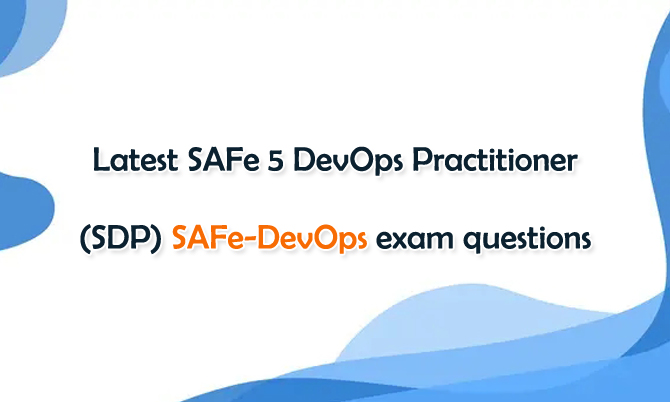SAFe 5 DevOps Practitioner (SDP), also known as the
Scrum SAFe-DevOps exam, is one certification of Scrum exams. Testpassport has collected complete the latest and most accurate questions and answers to prepare for your SAFe-DevOps exam. These Scrum SAFe-DevOps exam questions and answers are obtained based on recent test center information, and then experts try their best to organize and edit them. Scrum SAFe-DevOps: SAFe 5 DevOps Practitioner (SDP) questions and answers will cover every topic on the exam to help you succeed in your Scrum SAFe-DevOps certification.
SDP - SAFe DevOps Practitioner
A Certified SAFe 5 DevOps Practitioner (SDP) is a SAFe professional responsible for improving the complete flow of value through a Continuous Delivery Pipeline from idea to operational solution. Key areas of responsibility include participating in Continuous Exploration, Continuous Integration, Continuous Deployment, Release-on-Demand, continuous testing, continuous security, and building a culture of shared responsibility.
Exam Details
Duration: 90 minutes
Number of questions: 45
Passing score: 33/45 (73%)
Competency level: Intermediate, Proficient, Capable, can perform tasks with some assistance
Question format: Multiple choice (one answer) or multiple select(2-3 answers)
Delivery: Web-based, closed bool, no outside assistance, timed
Assess: Community platform upon completion of the course
Language offered:English
Cost: First attempt include in the course registration fee if taken within 30 days of course completion. Each retake or attempt past the 30 day window is $50
Exam Objectives
Introducing DevOps (11%)
Mapping your value stream (13%)
Gaining alignment with continuous exploration (31%)
Building quality in with continuous integration (31%)
Reducing time-to-market with continuous deployment (4%)
Delivering business value with the release on demand (7%)
Taking action (3%)
Share SAFe 5 DevOps Practitioner (SDP) SAFe-DevOps Sample Questions
1.Where do features go after Continuous Exploration?
A. Into Continuos Integration where they are then split into stories
B. Into the Portfolio Backlog where they are then split into stories
C. Into Continuous Integration where they are deployed with features toggles
D. Into Continuos Development where they are implemented in small batches
Answer: A
2.Which statement describes what could happen when development and operations do not collaborate early in the pipeline?
A. Surprises are found in deployment that lead to significant rework and delay
B. Automation of integration test is not possible
C. Teams build things quickly but build the wrong things
D. Lead times are reduced
Answer: C
3.What work is performed in the Build activity of the Continuous Delivery Pipeline?
A. Automated acceptance testing
B. Code review
C. Code
D. Compile
Answer: D
4.What is the desired frequency of deployment in SAFe?
A. Continuous
B. Daily
C. Once per Iteration
D. Once per PI
Answer: A
5.After the team maps the steps of the current state Value Stream during value stream mapping, what are the next two steps? (Choose two.)
A. Identify who is involved in each step
B. Create a future state value stream map
C. Perform a SWOT analysis
D. Calculate the Activity Ratio
E. Measure the performance at each step
Answer: A,E
6.What is the main goal of a SAFe DevOps transformation?
A. To create a strong DevOps team with leadership support
B. To create immutable infrastructure to avoid changes to the production environment
C. To implement an advanced tool chain to automate the entire Continuous Delivery Pipeline
D. To align people across the Value Stream to deliver value continuously
Answer: D
